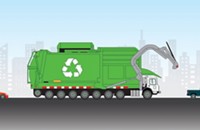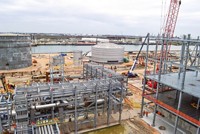Advertisement
Grab your lab coat. Let's get started
Welcome!
Welcome!
Create an account below to get 6 C&EN articles per month, receive newsletters and more - all free.
It seems this is your first time logging in online. Please enter the following information to continue.
As an ACS member you automatically get access to this site. All we need is few more details to create your reading experience.
Not you? Sign in with a different account.
Not you? Sign in with a different account.
ERROR 1
ERROR 1
ERROR 2
ERROR 2
ERROR 2
ERROR 2
ERROR 2
Password and Confirm password must match.
If you have an ACS member number, please enter it here so we can link this account to your membership. (optional)
ERROR 2
ACS values your privacy. By submitting your information, you are gaining access to C&EN and subscribing to our weekly newsletter. We use the information you provide to make your reading experience better, and we will never sell your data to third party members.
Business
Turning Around Polyester Resin
Polyethylene terephthalate producers hope consolidation will improve the market
by Alexander H. Tullo
February 7, 2011
| A version of this story appeared in
Volume 89, Issue 6

The experience of the North American polyethylene terephthalate (PET) industry in recent years shows that companies can manufacture a great product and enjoy robust growth but still not make much in the way of profits.
PET is clear, has strong gas-barrier properties, and is readily recycled. Over the past two decades, few, if any, polymers have posted such strong growth. And yet some PET producers have lost money, as Eastman Chemical did from 2007 to 2009. One company, Wellman, even filed for bankruptcy in 2008.
The problem was that as fast as demand grew, PET producers added new capacity even faster. Now, as the market matures, producers can no longer count on strong growth. In fact, demand actually declined in the recessionary years of 2008 and 2009.
The years of expansion have given way to a period of consolidation and capacity removal, thereby setting the stage for sustained profitability of the surviving players. Eastman, once the world’s largest PET producer, has completed its exit from the business by selling its U.S. PET operations to DAK Americas, a subsidiary of Mexico’s Alfa. Invista has agreed to sell plants in the U.S. and Mexico to Thailand’s Indorama, a company unheard of in North America a decade ago.
PET is made via esterification and polycondensation of ethylene glycol and purified terephthalic acid. So-called melt phase PET has a low intrinsic viscosity and is extruded into polyester fibers. Further reacting the polymer boosts its molecular weight and increases its intrinsic viscosity to yield “solid state” PET, which is used in beverage bottles and other packaging applications.
After penetrating the carbonated soft drink market in the 1980s with 2-L bottles, PET saw its heyday in the 1990s with the introduction of 20-oz soda bottles. As that application matured, the industry next saw meteoric growth in 0.5-L water bottles and other containers. In the 1990s and the 2000s, annual PET demand often expanded at double-digit rates.
The last two years of strong PET market expansion in North America were 2006 and 2007, when the market grew by 6% and 5%, respectively, says Tom Sherlock, resins business director at DAK. After the onset of the recession, the market declined nearly 4% in 2008 and another 3% in 2009.
During those years, consumers didn’t have disposable income to splurge on soft drinks. Sherlock says they shied away from convenience stores, a “powerhouse” for the PET industry. “If you go into a convenience store and look at those glass refrigerators, 90% of those products are made of PET,” he says. And in those years of the “staycation,” the public didn’t travel much, crimping demand not only at convenience stores but also in airports and other venues where people tend to buy beverages.
PET also slumped because of “down-gauging.” When oil prices soared in 2006 and 2007, bottlers opted for thinner-walled containers to save raw materials. This hit PET’s strongest-growing market, water bottles, which can be thinned more easily than soda bottles because they don’t need to hold in carbon dioxide.
Chase Willett, director of polyester and polyester raw materials at the Houston-based consulting group Chemical Market Associates Inc. (CMAI), says bottle weights were cut in half, to about 9 g. “It was a win-win for these beverage manufacturers,” he says. “They had a smaller energy footprint, and at the same time the bottle cost less,” he says.
The down-gauging trend has largely played out, Willett says. “There is not another 9 g to take,” he points out.
The decline in PET consumption also seems to have played out. Willett figures that the North American market grew 1% in 2010, and he expects about 2% growth this year. He doesn’t see demand recovering to its 2007 peak until 2015.
In the meantime, the market will struggle to absorb excess capacity. Observers complain that it has been too easy to flood the 9 billion-lb-per-year market with additional pounds. A new PET plant can be constructed at nearly double the size and for about half of the cost of a PET plant built just a few years earlier, Willett says.
“This is fine when it happens for a laptop PC but not when you are building a big petrochemical plant,” he says. In such a market, new plants have a big economic advantage over existing plants, even ones constructed in recent memory.
The newest of those plants is a $140 million, 950 million-lb-per-year facility that Indorama opened in 2010 in Decatur, Ala. In 2007, Eastman started up a 770 million-lb plant in Columbia, S.C., that incorporates its then-new IntegRex technology. It expanded the facility by about 385 million lb in 2008, in a project that cost $100 million.
DAK expanded its plant in Cape Fear, N.C., by 450 million lb in 2007. The company recently opened a PET recycling joint venture with Shaw Industries in Fayetteville, N.C., that can recycle 160 million lb of bottles annually.
But adding recycling capacity isn’t the same as adding virgin capacity to the PET market, DAK’s Sherlock is quick to point out. Most of the recycled bottles go into fiber applications such as carpet. In addition, recycling improves the environmental profile of PET and makes packaging companies more comfortable with choosing it over other resins.
PET producers are finally starting to show some restraint. In 2007, Italy’s Mossi & Ghisolfi announced it would build a 1.8 billion-lb PET plant in the U.S., but the firm opted instead for 400 million lb in capacity expansion split between two existing plants. “After the recession hit, the PET market went into reverse,” and the need for the new plant disappeared, says Mark Adlam, North American business director for M&G Polymers.

CMAI’s Willett doesn’t expect another large plant to be built for at least five years. The only new capacity in the works is that of private-equity-backed firm Selenis, which bought an idled polytrimethylene terephthalate plant in 2009 from Shell Chemical and Société Générale de Financement du Québec. Selenis plans to convert the plant into a relatively small PET unit.
And companies have been taking capacity out of the market. Eastman shut down 880 million lb of conventional PET capacity in 2007 and 2008. Invista also closed older PET capacity. And under bankruptcy, Wellman shuttered polyester resin and fiber capacity.
With the market saturated, large North American producers have shifted their attention to consolidation. This allows them to grow without adding capacity and at the same time eliminate competitors. With their purchases, both Indorama and DAK took out producers that were bigger than they were.
These firms’ plans for their new businesses are modest. When asked whether Indorama will shut down any of the capacity it acquired, a spokesman answers “absolutely not.” He says the company intends to boost operating rates at its newly acquired Invista facilities to 100% from 80%.
In addition, Indorama says Invista’s plant in Mexico is a big part of its acquisition rationale: A possible future expansion at that site will help it serve the Latin American market.
Observers think this round of consolidation strengthens the market. “It is a needed thing,” M&G’s Adlam says. “There were too many players in PET before, and having a consolidated industry helps. You’re left with serious players in PET, the ones that will be growing for their customers as opposed to ones that are getting ready to exit.”
CMAI’s Willett agrees. Consolidation “helps producers get back to a more sustainable business model,” he says. “But I don’t think it helps them get back to a model where they’ll mint money.”




Join the conversation
Contact the reporter
Submit a Letter to the Editor for publication
Engage with us on Twitter